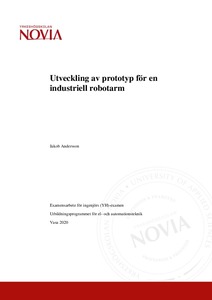Utveckling av prototyp för en industriell robotarm
Andersson, Jakob (2020)
Andersson, Jakob
2020
All rights reserved. This publication is copyrighted. You may download, display and print it for Your own personal use. Commercial use is prohibited.
Julkaisun pysyvä osoite on
https://urn.fi/URN:NBN:fi:amk-2020052213100
https://urn.fi/URN:NBN:fi:amk-2020052213100
Tiivistelmä
Industriella robotlösningar har sedan länge varit en betydande del av världens industri. Industriella robotar används globalt i ett stort antal industrier och implementering av nya robotlösningar ökar årligen, med en ökning på 400 000 enheter under året 2018.
Examensarbetet behandlar uppbyggnaden av en artikulerande robotarm, som styrs via ett gränssnitt beläget på ett Linux system genom seriell kommunikation.
Den teoretiska delen av arbetet beskriver tillvägagångsätt och riktlinjer som bör användas för att designa tredimensionella objekt, metoder för att lösa kinematik problem och beskriver den använda hårdvaran och mjukvaran. Den praktiska delen av arbetet beskriver designstegen av en fysisk robotarm, upprätthållning av seriell kommunikation mellan gränssnitt och hårdvara, konfigurering av hanteringsgränssnittet Rviz samt programmering i kodspråken C/C++, för att behandla ledpositionsdata och konvertera positionerna till användbara styrsignaler för stegmotorer.
Resultatet är en fungerande prototyp som är designad i CAD verktyget Fusion 360 och styrs av seriella meddelanden från användargränssnittet Rviz, som är beläget på ett Linux system. For a long time, industrial robotic solutions have been a significant part of the world's industry. Industrial robots are used globally in a large number of industries and the implementation of new robotic solutions is increasing annually, with an increase of 400,000 units in the year 2018.
The thesis deals with the construction of an articulating robot arm, which is controlled via an interface located on a Linux system through serial communication.
The theoretical part of the work describes the procedures and guidelines that should be used to design three-dimensional objects, methods to solve kinematics problems, as well as the hardware and software used. The practical part of the work describes the design steps of a physical robot arm, maintenance of serial communication between interface and hardware, configuration of the Rviz management interface and programming in the code languages C/C++ to process joint position data and convert the positions into useful control signals for stepper motors.
The result is a working prototype designed in the Fusion 360 CAD tool and controlled by serial messages from the Rviz user interface, which is located on a Linux system.
Examensarbetet behandlar uppbyggnaden av en artikulerande robotarm, som styrs via ett gränssnitt beläget på ett Linux system genom seriell kommunikation.
Den teoretiska delen av arbetet beskriver tillvägagångsätt och riktlinjer som bör användas för att designa tredimensionella objekt, metoder för att lösa kinematik problem och beskriver den använda hårdvaran och mjukvaran. Den praktiska delen av arbetet beskriver designstegen av en fysisk robotarm, upprätthållning av seriell kommunikation mellan gränssnitt och hårdvara, konfigurering av hanteringsgränssnittet Rviz samt programmering i kodspråken C/C++, för att behandla ledpositionsdata och konvertera positionerna till användbara styrsignaler för stegmotorer.
Resultatet är en fungerande prototyp som är designad i CAD verktyget Fusion 360 och styrs av seriella meddelanden från användargränssnittet Rviz, som är beläget på ett Linux system.
The thesis deals with the construction of an articulating robot arm, which is controlled via an interface located on a Linux system through serial communication.
The theoretical part of the work describes the procedures and guidelines that should be used to design three-dimensional objects, methods to solve kinematics problems, as well as the hardware and software used. The practical part of the work describes the design steps of a physical robot arm, maintenance of serial communication between interface and hardware, configuration of the Rviz management interface and programming in the code languages C/C++ to process joint position data and convert the positions into useful control signals for stepper motors.
The result is a working prototype designed in the Fusion 360 CAD tool and controlled by serial messages from the Rviz user interface, which is located on a Linux system.
